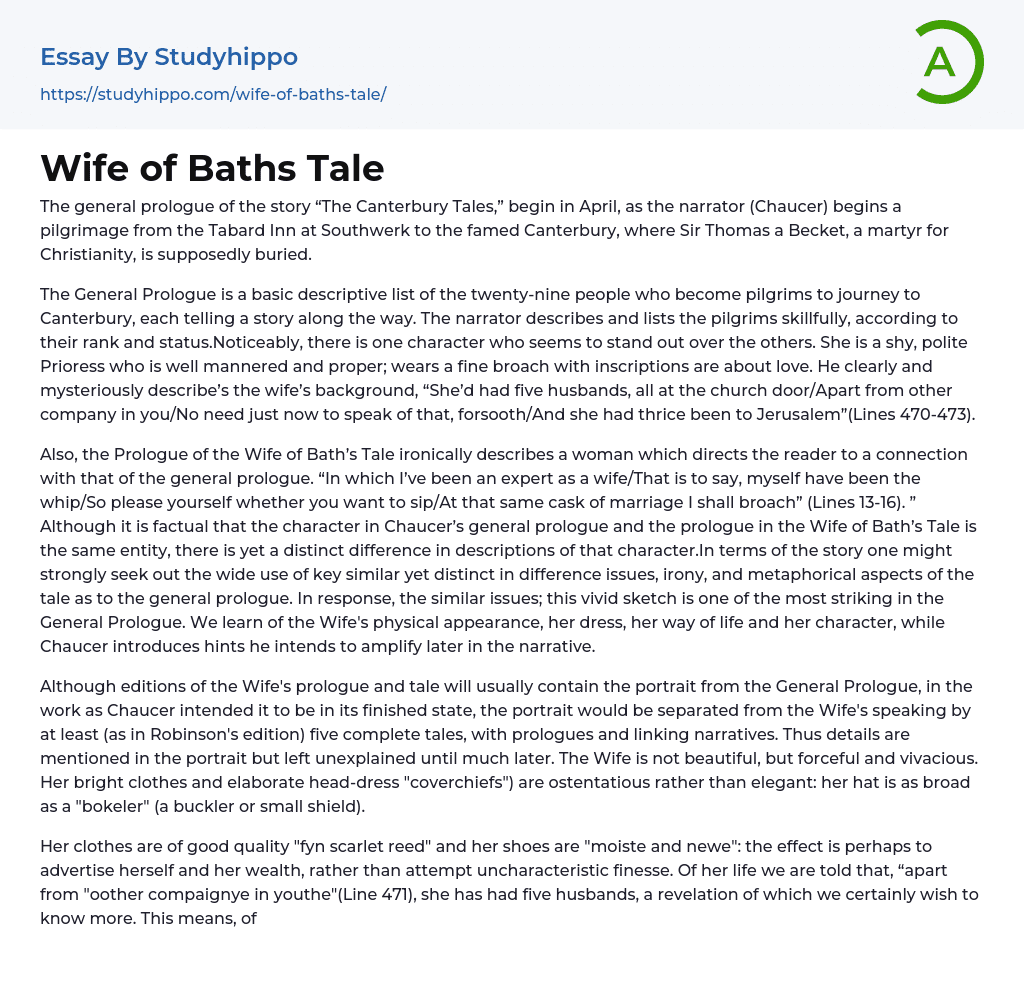The general prologue of the story “The Canterbury Tales,” begin in April, as the narrator (Chaucer) begins a pilgrimage from the Tabard Inn at Southwerk to the famed Canterbury, where Sir Thomas a Becket, a martyr for Christianity, is supposedly buried.
The General Prologue is a basic descriptive list of the twenty-nine people who become pilgrims to journey to Canterbury, each telling a story along the way. The narrator describes and lists the pilgrims skillfully, according to their rank and status.Noticeably, there is one character who seems to stand out over the others. She is a shy, polite Prioress who is well mannered and proper; wears a fine broach with inscriptions are about love. He clearly and mysteriously describe’s the wife’s background, “She’d had five husbands, all at the church door/Apart from oth
...er company in you/No need just now to speak of that, forsooth/And she had thrice been to Jerusalem”(Lines 470-473).
Also, the Prologue of the Wife of Bath’s Tale ironically describes a woman which directs the reader to a connection with that of the general prologue. “In which I’ve been an expert as a wife/That is to say, myself have been the whip/So please yourself whether you want to sip/At that same cask of marriage I shall broach” (Lines 13-16). ” Although it is factual that the character in Chaucer’s general prologue and the prologue in the Wife of Bath’s Tale is the same entity, there is yet a distinct difference in descriptions of that character.In terms of the story one might strongly seek out the wide use of key similar yet distinct in difference issues, irony, and metaphorical aspects of the tale as t
the general prologue. In response, the similar issues; this vivid sketch is one of the most striking in the General Prologue. We learn of the Wife's physical appearance, her dress, her way of life and her character, while Chaucer introduces hints he intends to amplify later in the narrative.
Although editions of the Wife's prologue and tale will usually contain the portrait from the General Prologue, in the work as Chaucer intended it to be in its finished state, the portrait would be separated from the Wife's speaking by at least (as in Robinson's edition) five complete tales, with prologues and linking narratives. Thus details are mentioned in the portrait but left unexplained until much later. The Wife is not beautiful, but forceful and vivacious. Her bright clothes and elaborate head-dress "coverchiefs") are ostentatious rather than elegant: her hat is as broad as a "bokeler" (a buckler or small shield).
Her clothes are of good quality "fyn scarlet reed" and her shoes are "moiste and newe": the effect is perhaps to advertise herself and her wealth, rather than attempt uncharacteristic finesse. Of her life we are told that, “apart from "oother compaignye in youthe"(Line 471), she has had five husbands, a revelation of which we certainly wish to know more. This means, of course, that she has been five times widowed (no divorce for women in 14th century England).Her habit of going on pilgrimages suggests a devout woman, but her real reasons for such travel are a love of adventure, and the social opportunities these trips bring. As in the present case, most pilgrims are men (and the few other women present are nuns). One of
them might be the next husband for whom she is looking out! The last part of the description tells us of her social skills, especially her knowledge of "remedies of love", an "art" which she well understands.
Irony is a form of speech in which the real meaning is concealed or contradicted by the words used. In the prologue of the Wife of Bath,
- Book Summary essays
- Metaphor essays
- Reader essays
- Rhyme essays
- Literary devices essays
- Villain essays
- Books essays
- Genre essays
- Literary Criticism essays
- Writer essays
- Protagonist essays
- Simile essays
- Poem essays
- Book Report essays
- Book Review essays
- Greek Mythology essays
- Plot essays
- Tragic Hero essays
- Coming of Age essays
- Play essays
- Rhetoric essays
- Rhetorical Question essays
- Translation essays
- Understanding essays
- Reason essays
- Character essays
- Letter essays
- American Literature essays
- Literature Review essays
- Utopia essays
- Poetry Analysis essays
- Dante's Inferno essays
- Between The World and Me essays
- Incidents in The Life of a Slave Girl essays
- Flowers for Algernon essays
- Myth essays
- Everyday Use essays
- Boo Radley essays
- Genesis essays
- Richard iii essays
- Alice in Wonderland essays
- On the road essays
- Ozymandias essays
- The Nightingale essays
- Holden Caulfield essays
- Animal Farm essays
- 1984 essays
- A Hanging essays
- Shooting An Elephant essays
- A Tale Of Two Cities essays




